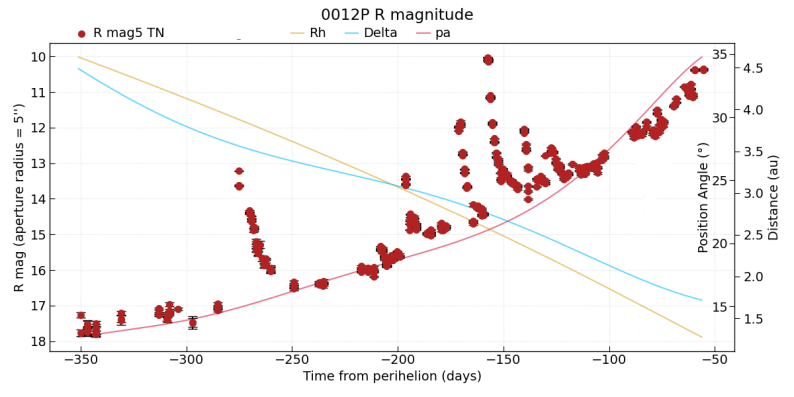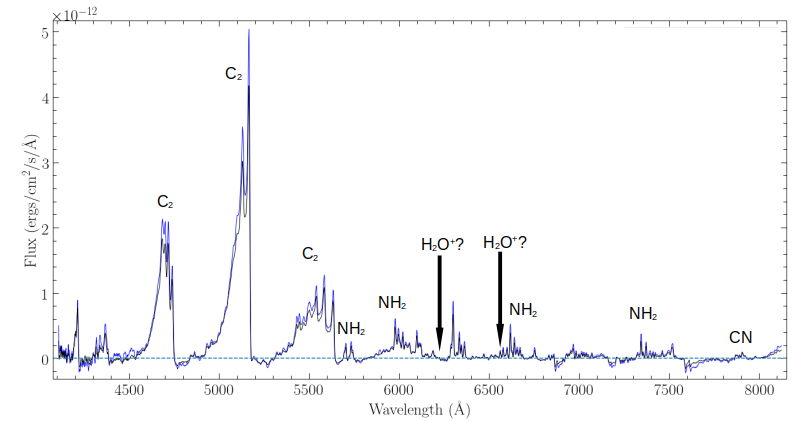- 1University of Liege, Space sciences, Technologies and Astrophysics Research (STAR), Belgium (mathieu.vanderdonckt@uliege.be)
- 2Physical Research Laboratory, Navarangpura, Ahmedabad, 380058, Gujarat, India
- 3Aix Marseille Univ, CNRS, CNES, LAM, Marseille, France
- 4Oukaimeden Observatory, High Energy Physics and Astrophysics Laboratory, Cadi Ayyad University, Marrakech, Morocco
We present pre-perihelion photometric and spectroscopic observations of comet 12P/Pons-Brooks (hereafter 12P) during its 2024 passage. 12P is a comet on a Halley-type orbit with a period of 71 years that showed during its recent approach several impressive outbursts[1], with an interesting double horn shaped dust coma which earned it the nickname of "devil comet". The comet, discovered in 1812, had already experienced outbursts during previous passages [2]. We observed the comet over 125 nights with the TRAPPIST-North telescope [3] from May 6, 2023 (rh = 4.62 au), to March 16, 2024 (rh = 1.02 au), when it was too close to the Sun to be observed. We collected images with broad-band Johnson–Cousins filters (BVRI) as well as narrow-band HB filters [4] (OH, CN, C2, C3 and NH for gas species and BC, GC and BC for the dust continuum) to compute the comet lightcurve in BVRI, the gas activity using the Haser model [5], and the dust activity proxy af(0)rho [6]. From the lightcurve and images we detect at least 6 major outbursts with an increase up to 4 magnitudes (see Fig. 1 and [1]) along with gas and dust increase; OH production rate reaching values as high as 1029 molecules/s and af(0)rho as high as 105 cm. Interestingly, most of the outbursts where observed at a heliocentric distance higher than 3 au, where supervolatiles such as CO2 and CO probably drives cometary activity. It indicates that the outburst mechanism might be similar to other far away comets such as the centaur 29P/Schwassmann–Wachmann 1 that shows regular outbursts at an heliocentric distance of ~ 6 au [7]. The outbursts and their subsequent fall-off were observed with narrow-band filters allowing the study of the gas and dust ratios behavior during those events. The analysis of the images in the various filters shows the evolution of the peculiar 12P coma shape with the activity.
To complement the TRAPPIST photometric dataset, long-slit low resolution spectra were obtained at the Observatoire de Haute Provence with the MISTRAL instrument [8] (5.5’x1.9’’ slit, R∼700@6000 Å) on the night of March 23, 2024, when the comet was at a heliocentric distance of 0.94 au (Fig. 2). Spectra was extracted from the observed data and calibrated to analyse the emissions from the different molecular bands. While the usual emission bands from the neutral molecular species, C2 , NH2 , CN, are observed, additionally, a tentative detection of H2O+ has also been made.

Fig. 1: 12P/Pons-Brooks magnitude in the R band from the TRAPPIST survey. Several outbursts with a 1 to 4 magnitude increase can be observed. The lightcurve covers observations from May 6, 2023 (rh = 4.62 au), to February 25, 2024 (rh = 1.27 au)

Fig. 2: 120s spectra of 12P taken with MISTRAL at Observatoire de Haute Provence with a 1,9’’ wide slit, dust subtracted and extracted on the photocenter. Different emission bands are visible, including tentative detections of H2O+.
References
[1] ATel#16194, ATel#16202, ATel#16223, ATel#16229, ATel#16254, ATel#16270, ATel#16282, ATel#16315, ATel#16338, ATel#16343, ATel#16408, ATel#16498
[2] Gary W Kronk, Cometography: a catalog of comets. Vol. 4, 1933-1959, Cambridge University Press (2009)
[3] Jehin, E. et al. TRAPPIST: TRAnsiting Planets and PlanetesImals Small Telescope. The Messenger 145, (2011).
[4] Farnham, T. The HB Narrowband Comet Filters: Standard Stars and Calibrations. Icarus 147, 180–204 (2000).
[5] Haser, L. Distribution d’intensité dans la tête d’une comète. Bulletins de l'Académie Royale de Belgique 43 pp. 740-750 (1957)
[6] A'Hearn et al., Comet Bowell 1980b, The Astronomical Journal 89-4, 579-591 (1984)
[7] see the MISSION 29P campain: https://britastro.org/section_information_/comet-section-overview/mission-29p-2
[8] Schmitt, J. et al. Multi-purpose InSTRument for Astronomy at Low-resolution: MISTRAL@OHP. Preprint at http://arxiv.org/abs/2404.03705 (2024).
Acknowledgments
TRAPPIST is a project funded by the Belgian Fonds (National) de la Recherche Scientifique (F.R.S.-FNRS) under grant T.0120.21. This work is supported by the BIPASS program from the International Division of Department of Science and Technology (DST; Govt. of India) and the Belgian Federal Science Policy Office (BELSPO; Govt. of Belgium). M.V.D. acknowledges support from the French-speaking Community of Belgium through its FRIA grant
How to cite: Vander Donckt, M., Jehin, E., Krishnakumar, A., Adami, C., Hmiddouch, S., Ganesh, S., Benkhaldoun, Z., Delsanti, A., and Jabiri, A.: Pre-perihelion TRAPPIST monitoring of the outbursting Halley-type comet 12P/Pons-Brooks, Europlanet Science Congress 2024, Berlin, Germany, 8–13 Sep 2024, EPSC2024-951, https://doi.org/10.5194/epsc2024-951, 2024.